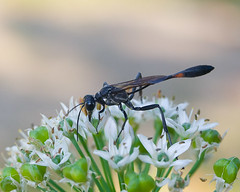Permaculture Guilds

As the summer begins to move into autumn I continue to harvest a variety of vegetables. I also set up a new keyhole bed near the cabin, the third in a series and planted it with cabbage and kohlrabi. Next on the list is to order a few berry bushes, probably currants and gooseberries to be planted as the shrub layer in the forest garden south of my cabin.
I’m also reading through a variety of books: Toby Hemenway’s Gaia’s Garden, Patrick Whitefield’s
How to Make A Forest Garden and Permaculture: A Designers' Manual by Bill Mollison.
It is often recommended in permaculture texts that chives as well as a variety of plants that have umbrella type flowers be planted under fruit trees so that the parasitic wasps have habitat and will more likely be around to control fruit tree pests. Pictured here is a parasitic wasp on the garlic chives in my spiral herb bed. Next spring I’ll be planting chives and dill as a part of the fruit tree centered guilds in the forest garden. I’m also leaving many pockets of native grasses and wildflowers such as Queen Anne’s Lace which grows everywhere around here and which provide fantastic insect habitat.
One Straw Revolution has an excellent Primer on Permaculture Guilds::
Guilding is one of the coolest gardening aspects of Permaculture theory. In Nature plants are grouped in small, reoccurring but loosely defined communities that are often referred to as guilds. A full guild can be said to have seven layers-each specifically designed to use one aspect of both the sun and root strata. On top will be the Large Trees, followed by the low trees, shrubs, herbs, vines, groundcovers, and finally ‘root’ plants. But Gaia is subtle, and the coordination goes far deeper than resource use. Each participant in the guild brings a wealth of diversity to the table. The tall tree may house small animals that distribute seeds for them, and the shrub layer may provide feed for birds that use the low trees for nesting habitat and feed on insects that prey on the large trees. Plants in the herb layer may fix nitrogen for all to use, and the ‘root’ plants may seek out pockets of nutrients in the soil that are made available to others in the guild as their foliage decomposes. Some plants will attract pollinators, others predatory insects. Some will act as mulch plants by creating excess biomass that regenerates the soil, while their neighbors may act as fortress plants protecting the entire guild from the encroachment of outside species. The inter-connectivity is how nature works-nice tidy systems that sufficiently supply the community with all of its needs given water and sunlight and a proper climate.
I’m fairly happy with the progress I’ve made in the first three months of our permaculture project. Of course it is just the beginning and we have just scratched the surface but given the economic and energy situation I’m glad to have gotten started. I see no reason for optimism in regards to energy or economy anytime in the near future. I don’t dwell on it though. I’m happy to be living here and happy to be doing the work that I’m doing. I know it is just a small effort but it is what I can do so I’ll do it.
Technorati Tags:
Conservation, Ecology, Economic Collapse, Economic Depression, Energy, Energy Conservation, Energy Crisis, Energy Shortage, Food, Food Production, Forest Gardening, Gardening, Insects, Living Simply, Natural Resources, Oil, Peak Energy, Peak Oil, Permaculture, Self Reliance